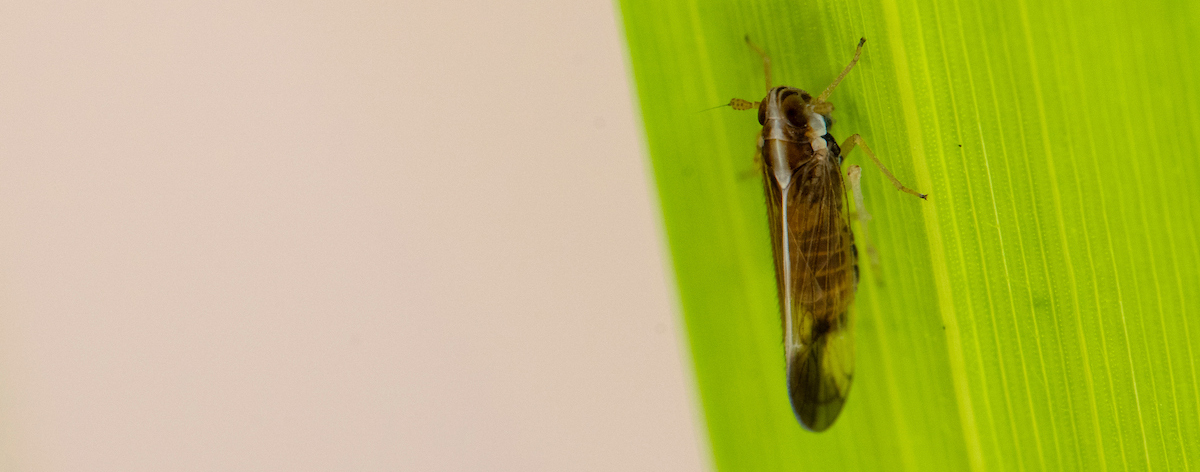Texas A&M AgriLife tackles rice delphacid devastation
Supports national task force, launches new insecticide trials to protect Texas rice
Texas A&M AgriLife experts are serving as key research and Extension partners in a new multistate response led by USA Rice to address the devastating spread of rice delphacid, an invasive pest now threatening thousands of acres across Texas, Louisiana, Arkansas and Mississippi.
Learn about rice delphacid
Texas A&M AgriLife is driving the effort to find solutions to the devastating pest and the virus it causes. Stay up-to-date with the latest information.
The task force unites rice growers, consultants and scientists from partner universities across the Southeast to coordinate urgent action, as Texas A&M AgriLife leads research, education and outreach efforts to help rice producers protect their crops and livelihoods.
“We are in a crisis situation,” said Sam Rustom, Ph.D., Texas A&M AgriLife Extension Service agronomist and assistant professor in the Texas A&M College of Agriculture and Life Sciences Department of Soil and Crop Sciences, Eagle Lake.
Texas rice producers typically plant 145,000-180,000 acres annually, making the state one of the top five rice-growing states in the U.S., according to the U.S. Department of Agriculture National Agricultural Statistics Service. Arkansas produces about 1.15 million acres, Louisiana grows 425,000-460,000 acres and Mississippi grows 125,000-155,000 acres. Texas primarily produces long-grain rice, including aromatic varieties like jasmine and basmati.
Rustom said the pest has already claimed thousands of acres in Texas in 2025, and no economically viable solutions currently exist to control it.
Texas A&M AgriLife’s rapid response
To mitigate the immediate threat and find long-term solutions, Rustom, alongside other experts across Texas A&M AgriLife, began working with researchers at both Louisiana State University and the University of Arkansas to identify new chemistries and practical management strategies to help producers control the pest and salvage this season’s crop.
The Texas A&M AgriLife Research and Extension Center at Beaumont, located at the epicenter of the outbreak in Texas, is leading the research and outreach for the Texas industry. Infestations of delphacid and the hoja blanca viral disease are even impacting the center’s own rice fields, according to Mithila Jugulam, Ph.D., center director and professor.
Lina Bernaola, Ph.D., a Texas A&M AgriLife Research entomologist in the Texas A&M Department of Entomology, has created a fact sheet to help the public understand the insect. She has already begun working with growers on insecticide efficacy trials at farm locations and within the Texas A&M AgriLife center at Beaumont to provide solutions to producers.

In addition, she is screening current commercial rice varieties for tolerance to this pest. She aims to develop, with the help of breeders, rice cultivars that are less susceptible to this pest. Her research lab is working to understand the biology — including the life cycle, feeding behavior and population dynamics — to provide critical insights for timing control measures of this pest and develop integrated pest management strategies.
Since the hoja blanca disease is transmitted by this pest, she is collaborating with Xin-Gen “Shane” Zhou, Ph.D., AgriLife Research plant pathologist and professor, Department of Plant Pathology and Microbiology, Beaumont, to understand virus detection and plant responses to the disease.
Currently, only two approved neonicotinoid insecticides, Endigo ZCX and Tenchu 20SG, are available under emergency exemptions for use in Texas, with registrations valid through 2025. Despite the ability to utilize these insecticides, management of rice delphacid in 2025 has been less than satisfactory. Researchers are tracking their effectiveness while monitoring signs of resistance.
Meanwhile, Rustom and David Kerns, Ph.D., AgriLife Extension entomologist, professor and associate department head for the Department of Entomology, are in growers’ fields daily. They are collecting data and results from different treatment combinations, timing and field outcomes to identify potential control recommendations. Entomology graduate students are also working to accelerate analysis and deliver real-time insights to producers.
Additionally, they are trying to quantify the overall impact of the pest on the state’s rice industry, which is expected to be significant.
Their ongoing efforts to find solutions will ultimately support the new task force, which is currently conducting research aimed at understanding the susceptibility of various rice cultivars and determining how integrating varietal resistance with other pest management strategies, such as cultural practices and chemical controls, might provide a sustainable and effective approach to controlling rice delphacid.
Understanding rice delphacid
Rice delphacid is an invasive pest in the U.S. from Central and South America and the Caribbean. The first rice delphacids were recorded in Texas in 2015 and have since spread throughout the Texas Rice Belt, especially in Colorado, Wharton and Matagorda counties.

The piercing and sucking planthoppers feed on rice plants, extracting sap and depriving the plant of essential nutrients, which causes damage known as “hopperburn,” characterized by yellowing leaves and scars on leaf blades. They also excrete excess sugar, called “honeydew,” which leads to the growth of sooty mold. In severe cases, this can lead to extensive plant dieback, stunted growth and substantial yield losses.
“We are concerned we now have an overwintering population, because even after hard freezes, they are being found in every rice field,” Rustom said. “Historically, it has been a ratoon crop pest that doesn’t get bad until late September and into October. But beginning last year, it started to become a problem in the main crop. Now it has been confirmed as a multistate issue.”
The tiny insect, about one-quarter inch long, also carries rice hoja blanca virus. This serious pathogen causes rice hoja blanca, or “white leaves,” disease. Infected plants can experience reduced tillering, stunted growth and severe yield losses.
Rustom said 2025 has been the worst year by far, likely due to the wetter weather. Rice delphacids typically increase in population a week or two after a heavy rain, conditions that have persisted across the rice belt this season.
Helping growers navigate a critical point
Ratoon fields should be monitored rigorously, especially from late September through October, when ratoon rice is in the reproductive stage. Historically, this time of year is when most rice delphacid infestations occur across the state. Fields should also be scouted rigorously in the weeks following rainfall events.
“We’re at a point where the growers need to make a difficult decision: they may have to spray the ratoon crop two or three times and spend upward of $100 per acre, if they don’t want to abandon their fields,” Rustom said.
He said many producers are trying to get their ratoon crop far enough along before an infestation is too devastating; if they can get their rice drained, they can typically make it through the infestation.
“We are estimating already about 20-30% of our second crop has been abandoned now, and we could see some more.”




